Class 10 Physical Science Solution WBBSE Chapter 6 Current Electricity Broad Answer Type Questions
Question 1. State Joule’s laws of heating effect of current.
Answer:
Joule’s Laws (1841):
1. First Law:
The amount of heat produced in a conductor in a given interval of time of proportion to the square of the current passed. Thus if H be the amount of heat generated in a conductor having resistance R when current 1 passes through it in time t, then
⇒ Hα I2 (When R and t are kept constant)
2. Second law:
The amount of heat produced by a given current in a given time is proportional of the resistance of the conductor.
⇒ H α R (When I and t are kept constant)
3. Third Law:
The amount of heat produced in a given conductor by a given current is proportional to the time for which the current passes.
⇒ Hα t (When I and R are kept constant)
Combining the three laws, we have:
⇒ H α I2 RT (When 1, R and t vary) or,
H = \(\frac{I^2 R T}{J}\)
IRT (J= mechanical equivalent of heat = 4.2 joule (calorie)
If I am in ampere, R in ohm, t in second, and H in calorie, then
H= \(\frac{I^2 R T}{J}\)
H= 0.241 RT calorie.
Question 2. Short Note:
- Ohmic resistance
- Non-ohmic resistance
Answer:
1. Ohmic Resistance :
The resistors, which obey Ohm’s Law are said to have ohmic resistances.
Example: All metal or metallic alloy.
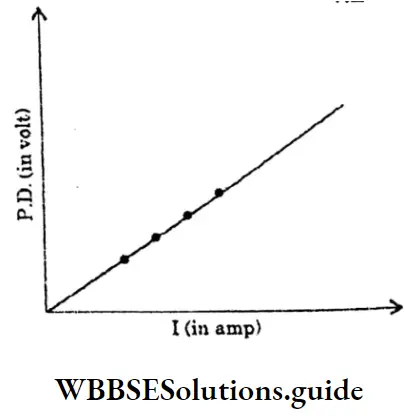
2. Non-ohmic resistance :
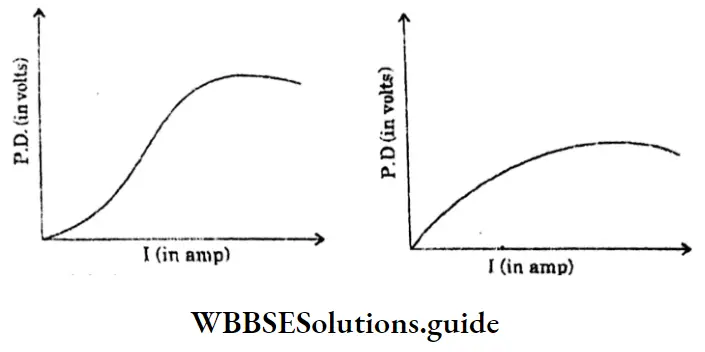
The resistors which do not obey Ohm’s law are said to have non-ohmic resistance.
Example: Electronic value.
Question 3. Two resistors of 30W and 60W are connected in parallel in an electric circuit. How does the current passing through the two resistors compare?
Answer:
Given
Two resistors of 30W and 60W are connected in parallel in an electric circuit
The potential difference across 30W = B potential difference across 60W
i.e I1 R1= I2 R2 Or,
⇒ \(\frac{I_1}{I_2}=\frac{R_2}{R_1}\)
= \(\frac{60 \Omega}{30 \Omega}\)
= 2
Question 4. Short Note-Direct Current.
Answer:
Direct Current:
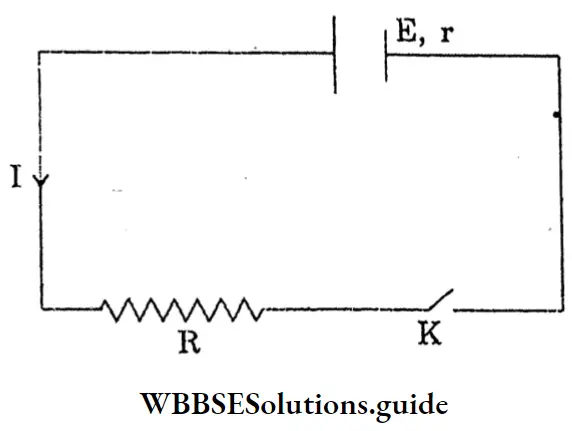
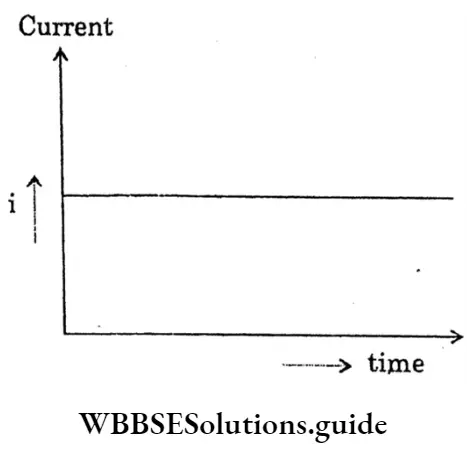
If a resistor connects with the two terminals of an electric cell, then through the resistor a steady current of constant magnitude flows in the same direction (from the positive pole of the cell to the negative pole) and this is called a direct current.
Class 10 Physical Science Solution WBBSE
Question 5. A resistance of 6 Ω is connected with a cell of em. f. 1.5 and negligible internal resistance calculate the current flowing through it.
Answer:
Given
A resistance of 6 Ω is connected with a cell of em. f. 1.5 and negligible internal resistance
V= IR Or, I= \(\frac{V}{R}\)
= \(\frac{1.5}{6}\)
= \(\frac{1}{4}\)
V = 0.25 Amp
The current flowing through it is 0.25 Amp
Question 6. Find the specific resistance of the material of a wire of length 100cm, area of cross-section 0.2 cm,2, and resistance 2 ohms.
Answer:
R = P× \(\frac{1}{\mathrm{~A}}\)
∴ P= \(\frac{\mathrm{RA}}{\mathrm{1}}\)
= \(\frac{20 \times 0.2}{100}\)
= 40 ×10-4 Ohm-cm
So,
R = 20hm
1 = 100 cm
A = 0.2 cm2
P= ?
Question 7. Find effective resistance of the resistors 2 ohm, 4 ohm, 5 ohm connected in
- Series
- Parallel.
Answer:
We know, for series combination equivalent resistance
R= r1+ r2+r3
= 2+4+5
= 11 ohm.
We also know, for parallel combination equivalent resistance.
⇒ \(\frac{1}{R}=\frac{1}{r_1}+\frac{1}{r_2}+\frac{1}{r_3}\)
= \(\frac{1}{2}+\frac{1}{4}+\frac{1}{5}\)
= \(\frac{19}{20}\)
∴ \(\frac{1}{R}\)= \(\frac{19}{20}\) Or,
= \(\frac{20}{19}\)
R = 1.05 Ohm
Question 8. Short Note-Electric Circuit.
Answer:
Electric Circuit: A continuous conducting path between the terminals of a source of electricity, is called an electric circuit.
Open electric → An electric circuit in which the flow of current stops, because of an open switch is called an open electric circuit. Closed electric
Open Electric Circuit:
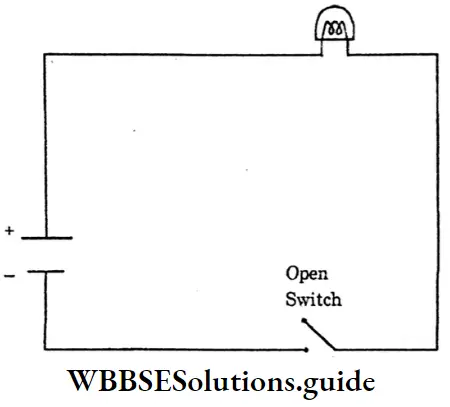
Closed Electric Circuit:
Circuit → An electric circuit in which a current flows continuously, because the switch is closed is called a closed electric circuit.
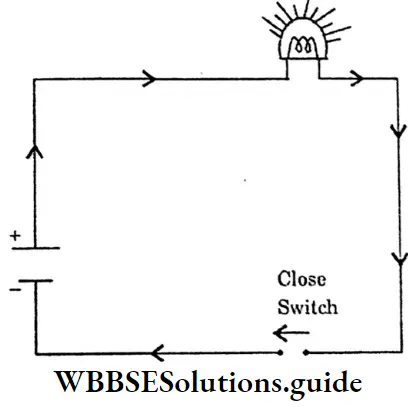
Question 9. There are two copper wires of equal length. The radius of one is twice the other. Find the ratio of their resistances.
Answer:
Given
There are two copper wires of equal length. The radius of one is twice the other.
We know, R= p \(\frac{1}{A}\)
= \(p \frac{1}{\lambda r^2}\)
(r= radius of the wire)
Since, the length and material are the same.
⇒ \(\mathrm{R} \alpha \frac{1}{\mathrm{r}^2}\)
i.e. \(\frac{R_1}{R_2}=\frac{r_2^2}{r_1^2}=\frac{\left(2 r_1\right)^2}{r_1^2}\)
= 4
∴ The thinner wire has a resistance four times the resistance of the thicker wire.
Question 10. Establish the relation between the emf, terminal voltage and internal resistance.
Answer:
The relation between the emf, terminal voltage and internal resistance
Let, a cell of emf E and internal resistance r is connected to an external resistance R
The total resistance of the circuit = R+r
So, the current drawn from the cells
I= \(\frac{e . m . f \text { of the cell }}{\text { total resistance }}\)
I= \(\frac{E}{R+r}\)
E= I (R+r)
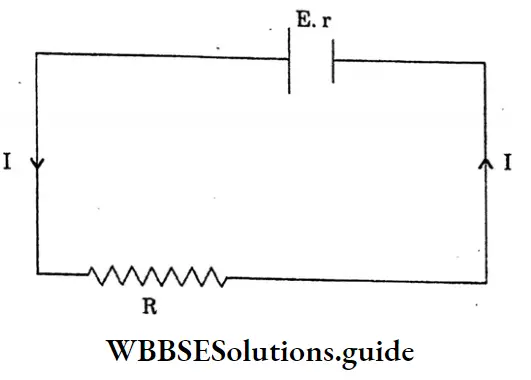
The terminal voltage of the cell, V = IR voltage (v) drops due to internal resistance -I As the work is done carrying a unit positive charge once through a complete circuit,
E = V + v
v = E-V
Internal resistance r = \(\frac{V}{I}\)
= \(\frac{E-V}{I}\)
= \(\frac{E-V}{V / R}\)
= \(R \cdot\left[\frac{E}{V}-1\right]\)
Question 11. A current of 0.5 ampere passes through a wire of resistance 2.5 ohm. for 1 hour. Find the heat produced.
Answer:
Given
A current of 0.5 ampere passes through a wire of resistance 2.5 ohm. for 1 hour.
We know,
H = \(\frac{I^2 R T}{J}\)
= \(\frac{I^2 R T}{4^2}\)
∴ H \(\frac{(0.5)^2 \times 2.5 \times 3600}{4^2}\)
= 535.7 caloric
So,
I = 0.5 ampere
R = 2.5 ohm
t = 1hr.
= 3600 sec.
H =?
Question 12. The resistance of a wire of cross-section area 0.01 cm2 is 10 ohm. What is the length of the wire? The specific resistance of the wire is 50 × 10-6 ohm-cm.
Answer:
Given
The resistance of a wire of cross-section area 0.01 cm2 is 10 ohm.
We know,
R = p = \(\frac{\ell}{\mathrm{A}}\) Or,
l= \(\frac{\mathrm{RA}}{p}\) Or,
l= \(\frac{10 \times 0.01}{50 \times 10^{-6}}\)
∴ l= 2000 cm
So,
R= 10 Ohm
A= 0.01 cm2
p= 50 × 10-6
Ohm–cm
1= ?
Question 13. What is the difference between e.m.f and p.d?
Answer:
Difference between e.m.f. and p.d. : e.m.f (electromotive force):
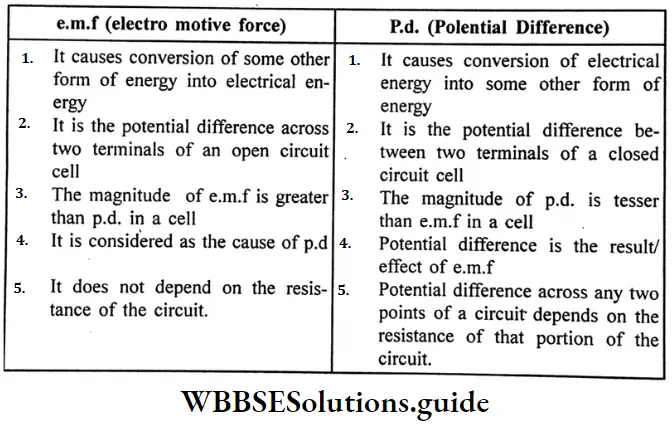
Question 14. A resistance of 6Ω is connected with a cell of e.m.f., 1.5 V, and negligible internal resistance, Calculate the current flowing through it.
Answer:
Given
A resistance of 6Ω is connected with a cell of e.m.f., 1.5 V, and negligible internal resistance
V = IR
I = \(\frac{V}{R}\)
I = \(\frac{1.5}{6}\)
I = \(\frac{1}{4}\)
= 0.25 Amp.
Question 15. A cell of e.m.f. 1.8v is connected to an external resistance of 22 when p.d. recorded at its terminal is 1.6v. Find the internal resistance of cell.
Answer:
Given
A cell of e.m.f. 1.8v is connected to an external resistance of 22 when p.d. recorded at its terminal is 1.6v.
E = 1.8V, V 1.6 volt, R = 2.2
Internal resistance = \(\frac{R(E-V)}{V}\)
= \( \frac{2(1.8-1.6)}{1.6}\)
= 0.25.Ω
